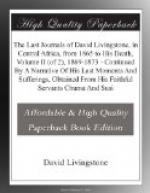29th March, 1871.—Crossed the Liya, and next day the Moangoi, by two well-made wattle bridges at an island in its bed: it is twenty yards, and has a very strong current, which makes all the market people fear it. We then crossed the Molembe in a canoe, which is fifteen yards, but swelled by rains and many rills. Came 7-1/2 miles to sleep at one of the outlying villages of Nyangwe: about sixty market people came past us from the Chitoka or marketplace, on the banks of Lualaba; they go thither at night, and come away about mid-day, having disposed of most of their goods by barter. The country is open, and dotted over with trees, chiefly a species of Bauhinia, that resists the annual grass burnings; there are trees along the watercourses, and many villages, each with a host of pigs. This region is low as compared with Tanganyika; about 2000 feet above the sea.
The headman’s house, in which I was lodged, contained the housewife’s little conveniences, in the shape of forty pots, dishes, baskets, knives, mats, all of which she removed to another house: I gave her four strings of beads, and go on to-morrow. Crossed the Kunda River and seven miles more brought us to Nyangwe, where we found Abed and Hassani had erected their dwellings, and sent their people over Lualaba, and as far west as the Loeki or Lomame. Abed said that my words against bloodshedding had stuck into him, and he had given orders to his people to give presents to the chiefs, but never fight unless actually attacked.
31st March, 1871.—I went down to take a good look at the Lualaba here. It is narrower than it is higher up, but still a mighty river, at least 3000 yards broad, and always deep: it can never be waded at any point, or at any time of the year; the people unhesitatingly declare that if any one tried to ford it, he would assuredly be lost. It has many large islands, and at these it is about 2000 yards or one mile. The banks are steep and deep: there is clay, and a yellow-clay schist in their structure; the other rivers, as the Luya and Kunda, have gravelly banks. The current is about two miles an hour away to the north.
FOOTNOTES:
[11] The epidemic here mentioned reached Zanzibar Island from the interior of Africa by way of the Masai caravan route and Pangani. Dr. Kirk says it again entered Africa from Zanzibar, and followed the course of the caravans to Ujiji and Manyuema.—ED.
[12] The men give indisputable proof that his body was eaten by the Manyuema who lay in ambush.—ED.
[13] Kanike is a blue calico.
CHAPTER V.
The Chitoka or market gathering. The broken watch. Improvises ink. Builds a new house at Nyangwe on the bank of the Lualaba. Marketing. Cannibalism. Lake Kamalondo. Dreadful effect of slaving. News of country across the Lualaba. Tiresome frustration. The Bakuss. Feeble health. Busy scene at market. Unable to procure canoes. Disaster to Arab canoes. Rapids in Lualaba. Project for visiting Lake Lincoln and the Lomame. Offers large reward for canoes and men. The slave’s mistress. Alarm of natives at market. Fiendish slaughter of women by Arabs. Heartrending scene. Death on land and in the river. Tagamoio’s assassinations. Continued slaughter across the river. Livingstone becomes desponding.




